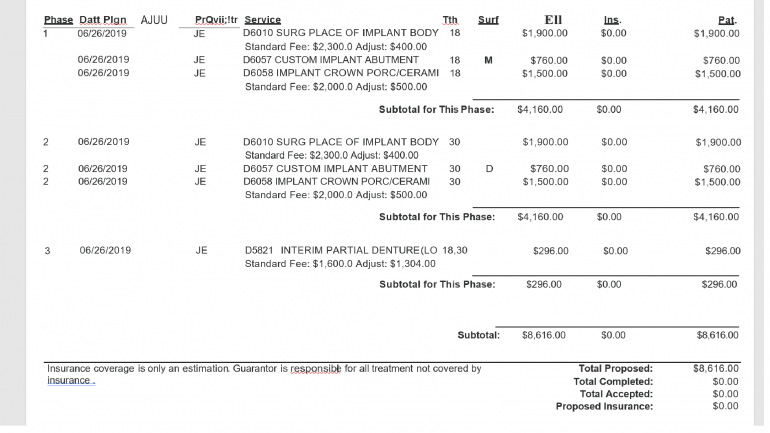
Dental Code D3120: Pulp cap - indirect (excluding final restoration)
Dental Code D3120 refers to a specific dental procedure known as an indirect pulp cap. This procedure is performed to treat deep carious lesions that approach or expose the pulp, which is the innermost part of a tooth containing nerves and blood vessels. The goal of an indirect pulp cap is to promote the healing and regeneration of the pulp tissue while preserving the vitality of the tooth.
Dental Code D3120 Price Range & Savings
On average, patients pay $100 for this D3120 service at the dentist's office, with as little as $50 charged for this in less expensive cities and as much as $130 in more expensive cities.
Low cost of living | Medium cost of living | High cost of living |
Memphis (Tennessee), Cincinnati (Ohio) | Miami (Florida), Denver (Colorado), Austin (Texas) | (New York (New York), San Francisco (California) |
$50 | $100 | $130 |
However, the price for the service D3120 depends not only on the region where you live, but also varies from dentist to dentist. Therefore, it makes sense to compare prices before choosing a dentist. The best way to do this price comparison is at Dr. BestPrice and save a lot of money.
Procedure Overview
The indirect pulp cap procedure involves several steps aimed at protecting the pulp and preventing the need for a root canal treatment. Let's take a closer look at each of these steps, ensuring a thorough understanding of the process.
Examination and Diagnosis
Before proceeding with any treatment, your dentist will conduct a thorough examination of your teeth and gums. They will visually assess the condition of your teeth and may take X-rays to evaluate the proximity and extent of the decay to the pulp. This step helps the dentist determine if an indirect pulp cap is appropriate for your situation.
Local Anesthesia
To ensure your comfort throughout the procedure, your dentist will administer a local anesthetic. This involves injecting a numbing medication around the affected tooth. The anesthetic blocks the transmission of pain signals, ensuring a painless experience during the treatment.
Isolation and Preparation
To create a clean and isolated environment, your dentist will use a rubber dam or a dental clamp to isolate the tooth being treated. This prevents saliva and other contaminants from interfering with the procedure and ensures a sterile working area. Once isolated, the decayed portion of the tooth is carefully removed using a dental drill. The dentist will remove the decay until they reach a thin layer of carious dentin closest to the pulp.
Protective Layer Application:
After the decayed dentin has been carefully removed, the next step in the indirect pulp cap procedure is the application of a protective layer to the exposed dentin. This protective layer plays a crucial role in promoting healing and preventing further damage to the pulp.
One of the most commonly used materials for the protective layer is a calcium hydroxide-based liner. Calcium hydroxide has several beneficial properties that make it an ideal choice for this purpose. Firstly, it possesses antimicrobial properties, which means that it helps to eliminate or inhibit the growth of bacteria present in the tooth. Bacteria can cause further damage to the pulp, so inhibiting their growth is essential for successful healing.
Additionally, the calcium hydroxide-based liner stimulates the formation of reparative dentin. Dentin is the hard, mineralized tissue that forms the bulk of the tooth structure. When the pulp is exposed or damaged, the body's natural response is to lay down a new layer of dentin to protect the pulp. This newly formed dentin is called reparative dentin.
Reparative dentin acts as a protective barrier, sealing off the pulp from any further bacterial penetration. It helps to prevent the bacteria from reaching the pulp and causing infection or inflammation. By stimulating the formation of reparative dentin, the calcium hydroxide-based liner aids in the natural healing process of the tooth.
Temporary Restoration
To seal the tooth and provide additional protection, a temporary restoration is placed over the protective layer. The temporary restoration can be in the form of a temporary filling or a crown. This temporary restoration helps to maintain the integrity of the tooth until a final restoration, such as a permanent filling or a dental crown, can be placed in a subsequent appointment. The temporary restoration ensures that the tooth is functional and protected during the healing process.
Follow-up and Evaluation
After the indirect pulp cap procedure, your dentist will schedule a follow-up appointment to monitor the healing progress of the tooth. During this visit, they will assess the vitality of the pulp and evaluate the success of the procedure. They may conduct tests, such as pulp vitality tests or imaging techniques, to evaluate the response of the pulp to the treatment. Based on the evaluation, your dentist will determine if any further treatment or restoration is needed.
Summary of Dental Code D3120
Dental Code D3120 involves an indirect pulp cap, a conservative approach to treating deep carious lesions that approach or expose the dental pulp. Preserving the vitality of the tooth is the primary objective of this procedure, aiming to avoid the need for more invasive treatments like root canal therapy. The procedure involves a thorough examination, local anesthesia, isolation and preparation of the tooth, application of a protective liner, temporary restoration placement, and follow-up evaluation. By following these steps, dentists can promote the healing and regeneration of the pulp tissue while preserving the natural tooth structure. If you require this procedure, consult with your dentist to determine the most appropriate treatment plan for your dental health. Remember, maintaining regular dental check-ups and practicing good oral hygiene are vital for preventing dental issues and preserving your overall oral health.
Supercharge your dental care with
Dr. BestPrice! Expertly compare costs, make savvy decisions, and prioritize your oral health without compromising your finances.